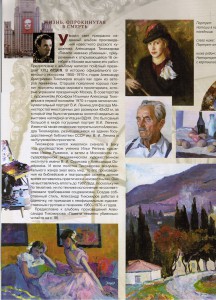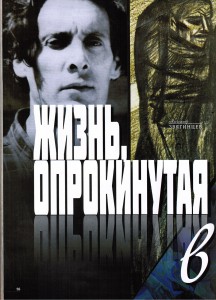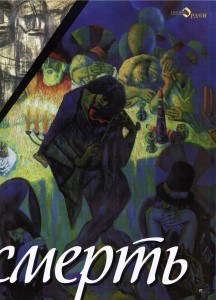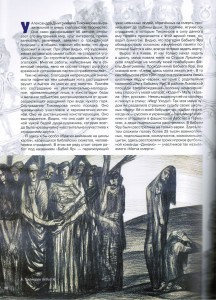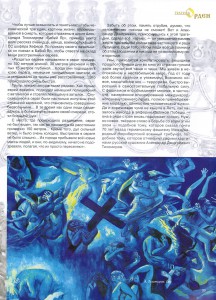Alexander Zvyagintsev
Secretary for the Union of Russian Authors
“Orden” magazin. October 2013
The art of Alexander Dmitrievich Tikhomirov is very expressive and verbal. It tells us about the author by itself, revealing his inner world, circle of interests, attachments, and hobbies, stating his position as a citizen – all in all, speaking about everything, which disturbs and tortures his soul. And still it is evident that the artist retains the will to remain himself, not endeavoring to suit the authorities. He is pernicious and independent, and at times even shocking. Many of his works, painted during the Soviet period, distinctly do not follow the spirit of time as well as the “rules of parties and the government”.
Nevertheless, thanks to enduring significance of themes, raised by him, the pinching feeling of compassion resounds and pours from many of his works. At that, his compassion is not sentimental or craven, expressed barely through statement of misfortune and overwhelmed with desire to distance himself from heartbreaking emotions at the sight of someone’s grief as soon as possible. The compassion of Tikhomirov is of a different kind. It is of immense sympathy and charismatic honesty. It is not of distant ascertaining. It is heartfelt. It can be seen that this compassion springs from the artist’s tortured soul, which has always been sensitive and open to the sufferings of other beings.
Here I would like to draw special attention to the series of works touching upon biblical theme of human sufferings. Same refers to series of works titled “Babi Yar”, where paralysing horror of innocent people being doomed to death touches you to the core. The hot, burning compassion with which Tikhomirov, by virtue of his talent, touches upon this ever-present theme, speaks volumes. Obviously Babi Yar tragedy keeps beating in his heart as a double-edged splint of a tortured memory, always ready to rupture the aorta.
I grew up in Kiev, and as soon as I started going to school, my mother took me to the Staroe Lukyanovskoe cemetery to see the grave of my great-grandmother, Fekla Dmitrievna. Passing by Babi Yar, she told me: “I could have been the one lying here”. On that morning in September 1941, she was seeing off her Jewish school friends, which were walking in a column, alongside their parents, towards Babi Yar. Near Lvovskaya Square the column’s supervisor, a German guard, asked my mother: “Jewish?” She replied: “No, Russian”. The German yanked her out of the group and pushed her away: “Weg! Leave!” This way, my mother was miraculously saved from sharing horrible fate of her school friends. Her and my grandmother’s turn came later, when they – the Russians and the Ukrainians – were forced into calf carriages and sent off to do labour in Germany under the Fascists. My grandfather, member of the underground, was shot. Not only Jews were eliminated in Babi Yar. Later on, 25 thousand prisoners of war, members of the underground, communists, members of the Komsomol, gypsies, laid their heads here. That’s where three players of the football team “Dynamo” – participants of so-called “Death Match” have been shot as well.
In order to better understand and see the scale of this human tragedy, paintings of life, demolished into death, portrayed in Alexander Tikhomirov’s cycle of “Babi Yar”, I’d like to present one story of an eyewitness, a German, the SS soldier and chauffeur Heffer. Under the order of his commander, he travelled to Babi Yar to deliver clothing of killed Jews to the warehouse.
“Stripped Jews were herded into a ditch of approximately 150 metres in length, 30 metres in width and whole 15 metres in depth… When they approached the edge of the ditch, German policemen grabbed them and laid them over the bodies of the already-shot… All this happened very fast. The motionless bodies laid in neat rows. As soon as a Jew laid down, he was approached by a German policeman with a machine gun, who shot the lying Jew in the back of the head… Those descending to the bottom of the pit were so horrified by the awful scene before them that they became completely powerless… While some people took off their clothes, and the majority awaited their turn, the atmosphere was filled with an overwhelming noise.
The ditch could not be seen from the place where people have been undressing, as it was situated at a distance of approximately 150 metres… In addition to that, it was very windy and cold. Not a shot taking place in the ditch could be heard… More and more masses of people were arriving from the town, and it seemed that they suspected nothing, assuming that they were simply going to be deported.
I believe that humanity will never be able to forget it, having switched off its memory! So is Alexander Dmitrievich, having touched upon this tragedy, has done everything he could to forever immortalise memory of the victims of this terrible war, for the sake of present and future. So that people always remember evil, which had befallen us, and so that such a tragedy could never be allowed to repeat.
We live in an unstable and turbulent world, which becomes more fragile and vulnerable year by year. A new extensive evil has surfaced – terrorism, which has rapidly grown into an independent global power. It has a lot of similarities with Fascism, – ignorance of international and internal legislation, complete obnoxiousness towards morality and the value of a human life. Neither has the brown plague yet sunk into oblivion, as it once seemed in the euphoria of the Great Victory. In several countries, it raises its head again. There is need for a new, firm say in the fight against all this evil – similar to that which was said almost seventy years ago now to German Fascism by the International Nuremberg Military Tribunal, something similar to that which the Russian artist, Alexander Tikhomirov, showed so distinguishably in his works.
